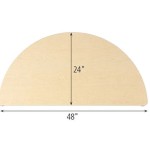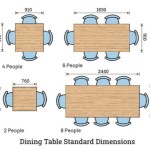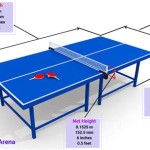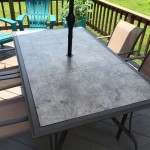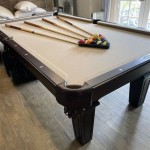How to Mark Your Pool Table
Marking a pool table can serve several purposes, ranging from identifying ownership and deterring theft to creating custom training aids for improving one's game. Careful consideration should be given to the type of marking, the location of the marking, and the potential impact on the table's surface and playability. This article will detail various methods for marking a pool table, providing guidance on choosing the appropriate approach for different needs and circumstances.
Before undertaking any marking process, it is imperative to assess the table's value and intended use. Permanently marking an antique or high-value table could significantly diminish its worth. Conversely, subtle and discreet marking on a less expensive table can provide a valuable means of identification. Furthermore, if the pool table is used recreationally, marking might be more focused on game enhancement. In contrast, if the table belongs to a commercial establishment, marking might be used to identify ownership and discourage theft.
Understanding the impact of different marking methods on the table's cloth is crucial. The cloth, typically made of wool or a wool-nylon blend, is a delicate surface that can be easily damaged. Scratches, abrasions, or the application of certain chemicals can impact the cloth's smoothness and therefore affect ball roll. Applying markings directly on the cloth is generally discouraged due to its detrimental effect on gameplay. Instead, marking techniques that minimize contact with the cloth or target other parts of the table are preferable.
Discreet Marking Methods for Identification
When the primary goal is to identify ownership without significantly altering the table's appearance or playability, discreet marking methods are advisable. These methods focus on marking less visible areas of the table, such as the underside of the rails, the inside of the pockets, or the frame of the table. These areas are typically not in direct contact with the balls during play and can therefore be marked without affecting gameplay.
One common method is to use a permanent marker to write identifying information, such as a name, contact number, or serial number, on the underside of the rails. This area is typically out of sight and relatively protected from wear and tear. When applying the marker, ensure the area to be marked is clean and dry to ensure the ink adheres properly. Use a fine-tipped marker to avoid excessive ink bleeding and maintain a neat appearance.
Another option is to use small, adhesive labels. These labels can be printed with identifying information and applied to the inside of the pockets or other hidden areas. Choose labels that are durable and resistant to moisture and fading. Clear labels are particularly effective as they blend in with the surrounding surface and are less noticeable. When applying the labels, ensure the surface is clean and free of debris to ensure proper adhesion.
For a more permanent marking option, consider using an engraver to etch identifying information into the wooden frame of the table. This method is more suitable for tables with solid wood frames and should be performed with caution to avoid damaging the surrounding area. Use a light touch and a fine-tipped engraving tool to create a clean and legible mark. Before engraving, practice on a scrap piece of wood to gain familiarity with the tool and technique.
Creating Training Aids with Marking Techniques
Marking a pool table can also be used to create custom training aids to improve one's game. By strategically marking specific points on the table, one can create visual references for aiming, positioning, and stroke development. This method can be particularly useful for practicing specific shots, such as cut shots, bank shots, and jump shots.
One approach is to use removable adhesive dots to mark key positions on the cloth. These dots can be purchased in various colors and sizes and can be easily removed without leaving residue. Choose dots that are small enough to avoid interfering with ball roll but large enough to be easily visible. Place the dots at strategic locations on the table, such as the diamond markers or along the path of specific shots.
Another method is to use chalk to temporarily mark lines or points on the cloth. Chalk can be used to draw aiming lines, create visual guides for stroke length, or mark the intended path of the cue ball. The chalk can be easily wiped away with a cloth when no longer needed. Use a light touch when applying the chalk to avoid excessive residue and ensure the chalk is clean and free of debris.
For a more permanent training aid, consider using a fabric paint marker to mark specific points on the cloth. These markers are designed to adhere to fabric and are resistant to fading and washing. However, it is important to note that these markings will be permanent and may affect the table's appearance. Use these markers sparingly and only in areas where the markings will not significantly impact gameplay.
Considerations for Commercial Pool Tables
When marking a pool table in a commercial establishment, such as a bar or pool hall, the primary objective is typically to deter theft and identify ownership. In these settings, more visible and permanent marking methods may be appropriate. However, it is still important to consider the impact of the marking on the table's appearance and playability. Overly intrusive markings can detract from the overall ambiance of the establishment and negatively impact the playing experience.
One common method is to use a branding iron to mark the wooden frame of the table. This method creates a permanent and easily recognizable mark that is difficult to remove or alter. The branding iron can be customized with the establishment's logo or name. Apply the branding iron to a discreet area of the frame, such as the underside or the back, to minimize the impact on the table's appearance.
Another option is to use tamper-evident labels to seal specific components of the table, such as the rails or the pockets. These labels are designed to break apart if tampered with, providing a visual indication that the table has been altered. The labels can be printed with identifying information and a warning message. Place the labels in strategic locations that are difficult to access or remove without damaging the label.
In some cases, it may be appropriate to mark the table's cloth with a permanent identification mark. However, this should be done with extreme caution and only as a last resort. Use a fabric paint marker to apply a small, discreet mark in an inconspicuous location, such as near the pocket or along the edge of the table. Ensure the mark is small and unobtrusive to minimize the impact on gameplay.
Regardless of the method chosen, it is essential to maintain detailed records of all markings. This documentation should include the location of the markings, the type of marking used, and the identifying information that was applied. This information can be invaluable in the event of theft or loss.

Pool Table Layout Dynamic Billiard Mississauga

How To Mark Your Pool Table Head Spot Foot And Line Full Diy Guide

Marking Your Pool Table To Play Snooker Technical Considerations

Layout Of A Pool Table Billiards Snooker And Darts Te Ara Encyclopedia New Zealand

How To Mark Measurements On A Pool Table Ehow

How To Mark Your Pool Table For Snooker Full Diy Guide

How To Estimate A Cut Angle Billiards And Pool Principles Techniques Resources

How To Mark Your Pool Table Head Spot Foot And Line Full Diy Guide

Sd Control Basic Billiards

Pool Table Series
Related Posts

